low fat diet food list pdf
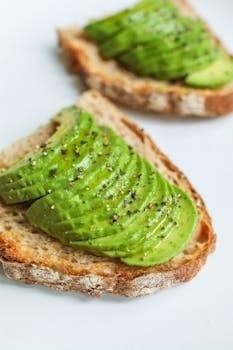
low fat diet food list pdf
Low Fat Diet Food List PDF⁚ A Comprehensive Guide
Embark on a journey to better health with our comprehensive guide to low-fat eating. This resource, available as a PDF, helps you navigate the world of low-fat diets for weight loss and muscle building.
Low-fat diets have gained popularity as a strategy for weight management and overall health improvement. This approach focuses on reducing the intake of dietary fats, particularly saturated and trans fats, while emphasizing nutrient-rich foods. A low-fat diet isn’t just about cutting fat; it’s about making informed choices to fuel your body with wholesome alternatives.
These diets often encourage a higher consumption of fruits, vegetables, lean proteins, and whole grains, contributing to a balanced nutritional profile; By limiting fatty foods like high-fat meats, full-fat dairy, and processed snacks, individuals can potentially lower their calorie intake and improve cardiovascular health. The key lies in understanding which foods to embrace and which to moderate.
This guide will provide a detailed food list and meal planning strategies to help you successfully implement a low-fat diet, paving the way for achieving your health and wellness goals.
Benefits of a Low-Fat Diet
Adopting a low-fat diet can offer a multitude of health advantages, extending beyond just weight management. One significant benefit is improved heart health. By reducing saturated and trans fats, you can lower cholesterol levels, decreasing the risk of heart disease and stroke.
Weight loss is another common outcome, as low-fat diets often lead to reduced calorie intake. This approach can also enhance digestive health by promoting the consumption of fiber-rich foods like fruits, vegetables, and whole grains. Furthermore, some studies suggest that low-fat diets may help regulate blood sugar levels, making them beneficial for individuals with diabetes or insulin resistance.
Beyond these, a low-fat diet can contribute to increased energy levels and improved overall well-being. Choosing lean proteins and complex carbohydrates provides sustained energy throughout the day, while minimizing processed foods reduces the intake of unhealthy additives and sugars. This dietary shift can empower you to feel your best, both physically and mentally.
Understanding Macronutrients⁚ Fat, Protein, and Carbohydrates
To effectively follow a low-fat diet, it’s crucial to grasp the roles of macronutrients⁚ fat, protein, and carbohydrates. Fat, while often demonized, is essential for hormone production, nutrient absorption, and cell function. However, different types of fats exist; prioritize unsaturated fats from sources like avocados and nuts, while limiting saturated and trans fats found in processed foods and fatty meats.
Protein is vital for building and repairing tissues, supporting immune function, and promoting satiety. Opt for lean protein sources such as poultry, fish, beans, and lentils.
Carbohydrates provide the body with energy. Choose complex carbohydrates like whole grains, fruits, and vegetables over simple sugars found in processed foods. Complex carbohydrates offer sustained energy and are rich in fiber, aiding digestion and promoting fullness.
Balancing these macronutrients is key to a successful low-fat diet. Aim for a diet that is lower in fat, moderate in protein, and rich in complex carbohydrates to achieve optimal health and weight management.
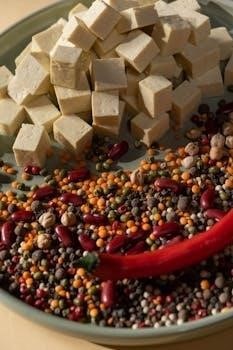
Foods to Include in Your Low-Fat Diet
Discover a variety of delicious and nutritious foods perfect for your low-fat diet. Embrace lean proteins, vibrant fruits, vegetables, and whole grains to create satisfying and healthy meals.
Lean Protein Sources
Incorporating lean protein sources is crucial for a successful low-fat diet, aiding in muscle building and weight management. Opt for skinless chicken breast, a versatile and readily available option. Fish, especially white fish like cod and tilapia, offers a fantastic source of protein and essential nutrients, while keeping fat content minimal.
Consider lean cuts of beef, such as sirloin or tenderloin, trimmed of visible fat. Turkey breast, similar to chicken, provides a lean and satisfying protein option. Legumes, including lentils and beans, are plant-based powerhouses, offering both protein and fiber. Tofu, a soy-based protein, is an excellent choice for vegetarians and vegans.
Egg whites are another low-fat protein source, perfect for omelets or smoothies. Remember to prioritize these lean protein sources to support your fitness goals and overall health within your low-fat dietary framework.
Fruits and Vegetables⁚ Low-Fat Choices
Fruits and vegetables are cornerstones of a healthy, low-fat diet, providing essential vitamins, minerals, and fiber. Berries like strawberries, blueberries, and raspberries are naturally low in fat and packed with antioxidants. Apples and pears offer a satisfying crunch and are excellent sources of fiber. Citrus fruits, such as oranges and grapefruits, are rich in Vitamin C and low in fat.
Leafy greens like spinach, kale, and lettuce are incredibly low in fat and packed with nutrients. Broccoli and cauliflower are cruciferous vegetables that offer numerous health benefits. Bell peppers, available in various colors, add flavor and vitamins to your meals. Cucumbers and celery are hydrating and low in calories, making them great snack options.
Tomatoes are versatile and rich in lycopene, an antioxidant. When selecting fruits and vegetables, prioritize fresh or frozen options without added sugars or fats to maximize their nutritional value within your low-fat dietary plan, supporting weight loss goals.
Grains and Starches⁚ Selecting Low-Fat Options
Grains and starches provide essential carbohydrates for energy, but choosing low-fat options is crucial for maintaining a balanced diet. Opt for whole grains like brown rice, quinoa, and oats, as they are naturally low in fat and high in fiber, promoting satiety and digestive health. These options are often found in healthy meal plans designed for weight loss.
When selecting bread, choose whole-wheat or multigrain varieties with minimal added fats or sugars. Be mindful of portion sizes, as excessive consumption of even healthy grains can contribute to weight gain. Consider incorporating sweet potatoes, which are a nutritious source of carbohydrates and fiber, and are naturally low in fat.
Avoid refined grains like white bread and processed cereals, as they are often higher in fat and lower in nutrients. By making informed choices about grains and starches, you can effectively manage your fat intake while still enjoying delicious and satisfying meals that support your dietary goals and overall well-being.
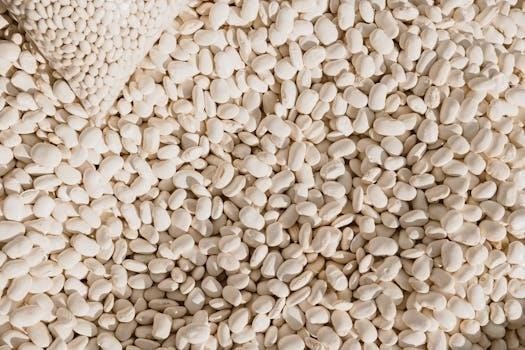
Foods to Limit or Avoid
Navigating a low-fat diet involves identifying foods high in fat. Awareness of these items is crucial for achieving weight loss goals and maintaining a healthy lifestyle. Mindful choices are key.
High-Fat Meats and Processed Foods
When adhering to a low-fat diet, it’s paramount to be mindful of your meat choices. High-fat meats, like fatty cuts of beef and pork, significantly contribute to overall fat intake. Processed foods, often laden with hidden fats and additives, should also be approached with caution. Many processed items contain high levels of saturated and trans fats, detrimental to cardiovascular health and weight management.
Opting for leaner protein sources is a strategic move in reducing fat consumption. Selecting skinless poultry, fish, and plant-based proteins can help achieve your dietary goals. Furthermore, preparing meals at home allows for greater control over ingredients, minimizing the intake of unhealthy fats found in processed foods. By consciously limiting high-fat meats and processed items, you pave the way for a healthier, low-fat lifestyle, aligning with your weight loss and overall wellness objectives. Reading labels is also important.
Full-Fat Dairy Products
Navigating the dairy aisle requires careful consideration when following a low-fat diet. Full-fat dairy products, such as whole milk, cream, and many cheeses, are significant sources of saturated fat. While dairy offers essential nutrients like calcium and vitamin D, their full-fat versions can hinder your low-fat goals. High saturated fat intake is linked to increased cholesterol levels and cardiovascular risks, making moderation crucial.
Fortunately, numerous low-fat and fat-free alternatives exist. Skim milk, Greek yogurt, and low-fat cottage cheese provide similar nutritional benefits without the excess fat. When selecting cheese, opt for reduced-fat varieties or use smaller portions of stronger-flavored cheeses to satisfy cravings without overdoing the fat content. Making these simple swaps can drastically reduce your saturated fat intake while still enjoying the benefits of dairy. Always read nutrition labels to make informed choices and stay within your dietary guidelines, supporting both your weight loss and health objectives.
Oils and Added Fats
Oils and added fats are a concentrated source of calories and, depending on the type, can significantly impact your health. While some fats are essential for bodily functions, many commonly used oils and added fats are high in saturated and trans fats, which should be limited in a low-fat diet. Butter, lard, and certain processed vegetable oils fall into this category. These fats can contribute to increased cholesterol levels and heart disease risk.
Hidden fats in processed foods also pose a challenge. Many packaged snacks, baked goods, and fried items contain high amounts of added fats to enhance flavor and texture. Reading nutrition labels carefully is crucial to identify and avoid these hidden sources. Instead of relying on unhealthy fats, focus on incorporating small amounts of healthy fats from sources like avocados, nuts, and seeds. When cooking, opt for low-fat methods like steaming, baking, or grilling to minimize the need for added oils. By being mindful of your oil and added fat intake, you can effectively support your low-fat dietary goals and promote overall well-being.
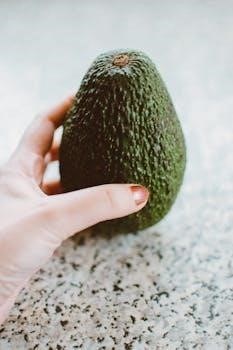
Sample Low-Fat Meal Plan
Explore a sample low-fat meal plan designed to guide you towards healthier eating. Discover delicious and nutritious options for breakfast, lunch, and dinner, alongside satisfying low-fat snack ideas to keep you energized.
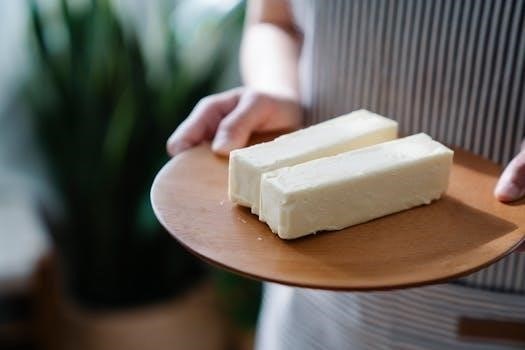
Breakfast, Lunch, and Dinner Ideas
Kickstart your day with a low-fat breakfast! Consider oatmeal with berries and a sprinkle of nuts or a veggie-filled omelet using egg whites. These options provide sustained energy without excess fat.
For lunch, explore lean protein sources like grilled chicken salad (dressing on the side!) or a hearty lentil soup. A turkey breast sandwich on whole-wheat bread is another satisfying choice, offering protein and fiber.
Dinner can be both delicious and low-fat. Baked fish with steamed vegetables is a classic. Chicken stir-fry with plenty of vegetables and a light soy sauce is also a winner. Remember portion control is key.
Experiment with spices and herbs to add flavor without relying on added fats. Planning ahead and prepping ingredients can make sticking to your low-fat diet much easier. Enjoy your culinary journey towards a healthier you!
Always remember to consult with a healthcare professional or registered dietitian for personalized dietary advice.
Snack Options
Smart snacking is essential for maintaining energy levels and preventing overeating during meals. Opt for low-fat choices that are both satisfying and nutritious. A small handful of almonds provides healthy fats and protein.
Fresh fruits like apples, berries, or bananas are naturally low in fat and packed with vitamins and fiber. Pair them with a dollop of non-fat Greek yogurt for added protein. Veggie sticks with hummus are another excellent option.
Air-popped popcorn (without butter!) is a surprisingly low-fat and filling snack. Rice cakes with a thin layer of avocado offer a combination of complex carbohydrates and healthy fats. Consider a hard-boiled egg for a protein boost.
Avoid processed snacks like chips, candy bars, and sugary drinks, as they are often high in fat and calories. Read food labels carefully to make informed choices. Portion control is crucial, even with healthy snacks.
Planning your snacks ahead of time can prevent impulsive decisions and keep you on track with your low-fat diet goals. Stay hydrated by drinking plenty of water throughout the day.